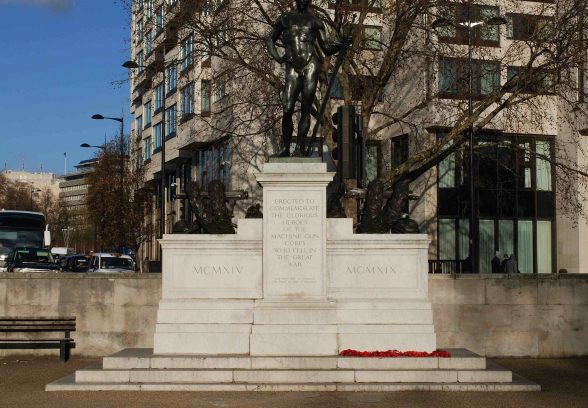This website uses cookies
This website uses cookies to enable it to function properly and to analyse how the website is used. Please click 'Close' to accept and continue using the website.



London: Machine Gun Corps
Status: Listed Grade II
Architect: Francis Derwent Wood
Location: Piccadilly, London
The Machine Gun Corps memorial was unveiled in 1925 to instant controversy, leading to protests by the International Arbitration League, letters in The Times, and discussion in the House of Commons. By 25th August 1925 Harold Phillips was writing to say that in his view the Machine Gun Corps Memorial Committee would unanimously oppose any alteration being made to the wording and writes “I hope these troublesome busy bodies will find another mares nest and leave our memorial in peace.”
The 9ft bronze figure of David presented the perfect image of the youthful soldier as well as the solitary nature of the machine gunner with deadly associations ‘Saul has slain his thousands, but David his ten thousands’ (Simon 18:6-7). The ‘Glorious Heroes’ are awarded with wreaths hung over life-size replications of machine guns, the instruments of mechanised massacre, to either side, accompanied by neatly-stacked soldier’s packs and helmets. The base was also designed by the sculptor and is of stainless Mazzona marble.
Francis Derwent Wood was Anglo-American by birth, raised in Switzerland and educated in Germany, before training at the Royal Academy and then under Thomas Brock, contributing the Australian figures to the latter’s Victoria memorial. Too old to enlist aged 41, Wood joined the Royal Army Medical Corps as an orderly in 1915, using his sculptural skills to make masks for those injured in the Great War. Rejecting the convention of rubber masks, Wood worked in metal and wood over weeks at a time, working from photographs of the men before their horrific injuries. He went on to set up the Department for Masks for Facial Disfigurement (1917-19). Casts were taken of the injured face, then used as a base for infilling the missing flesh and features. Masks were painted whilst worn so as to match the enamel paint to each patient’s colouring. Wood and his team may have treated only several hundred of over 20,000 men injured in the face, but they were able to restore their confidence and ease their return to normal life, as well as informing later developments in plastic surgery. Wood said of his role:
“my work begins where that of the surgeon ends. When the surgeon has done all he can to restore function, to heal wounds, to support fleshy tissue by bone grafting, I endeavour by means of the skill I happen to possess as a sculptor to make a mans face as near as possible to what it would look like before he was wounded”.
Wood went on to design war memorials in Liverpool and Ditchingham, Norfolk. The sculptor believed that memorials should not disguise the tragic reality of war. His bronze sculpture Canada’s Golgotha (1918) illustrated a Canadian solider crucified on a barn door, surrounded by laughing Germans. The story was later debunked, resulting in a government ban on publicly displaying the piece until 1992; new evidence was uncovered in 2002 confirming the incident.
Jon Wright
Either enter the name of a place or memorial or choose from the drop down list. The list groups memorials in London and then by country

Become a C20 member today and help save our modern design heritage.